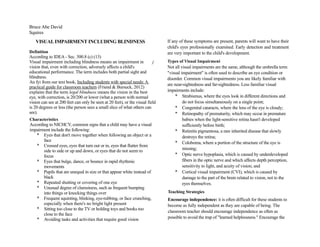
Visual impairment
- 1. Bruce Abe David Squires VISUAL IMPAIRMENT INCLUDING BLINDNESS If any of these symptoms are present, parents will want to have their child's eyes professionally examined. Early detection and treatment Definition are very important to the child's development. According to IDEA - Sec. 300.8 (c) (13) Visual impairment including blindness means an impairment in j Types of Visual Impairment vision that, even with correction, adversely affects a child's Not all visual impairments are the same, although the umbrella term educational performance. The term includes both partial sight and "visual impairment" is often used to describe an eye condition or blindness. disorder. Common visual impairments you are likely familiar with An fyi from our text book, Including students with special needs: A are near-sightedness and far-sightedness. Less familiar visual practical guide for classroom teachers (Friend & Bursuck, 2012) explains that the term legal blindness means the vision in the best impairments include: eye, with correction, is 20/200 or lower (what a person with normal * Strabismus, where the eyes look in different directions and vision can see at 200 feet can only be seen at 20 feet), or the visual field do not focus simultaneously on a single point; is 20 degrees or less (the person sees a small slice of what others can * Congenital cataracts, where the lens of the eye is cloudy; see). * Retinopathy of prematurity, which may occur in premature Characteristics babies when the light-sensitive retina hasn't developed According to NICHCY, common signs that a child may have a visual sufficiently before birth; impairment include the following: * Retinitis pigmentosa, a rare inherited disease that slowly * Eyes that don't move together when following an object or a destroys the retina; face * Coloboma, where a portion of the structure of the eye is * Crossed eyes, eyes that turn out or in, eyes that flutter from side to side or up and down, or eyes that do not seem to missing; focus * Optic nerve hypoplasia, which is caused by underdeveloped * Eyes that bulge, dance, or bounce in rapid rhythmic fibers in the optic nerve and which affects depth perception, movements sensitivity to light, and acuity of vision; and * Pupils that are unequal in size or that appear white instead of * Cortical visual impairment (CVI), which is caused by black damage to the part of the brain related to vision, not to the * Repeated shutting or covering of one eye eyes themselves. * Unusual degree of clumsiness, such as frequent bumping into things or knocking things over Teaching Strategies * Frequent squinting, blinking, eye-rubbing, or face crunching, Encourage independence: it is often difficult for these students to especially when there's no bright light present become as fully independent as they are capable of being. The * Sitting too close to the TV or holding toys and books too classroom teacher should encourage independence as often as close to the face * Avoiding tasks and activities that require good vision possible to avoid the trap of "learned helplessness." Encourage the
- 2. student to move independently through the classroom, and organize American Academy of Pediatrics lists types of health issues your classroom accordingly. affecting Communicate: with the student, with the students' parents, with eyes. special educators, the O & M specialist, and other teachers who have http://www.healtrivchildren.org/Englisri/health- more experience than you. issues/conditions/eyes/pages/Specific-Eye-Problems.aspx Learn about the student's specific visual impairment: what aspects Learning Strategies: of vision are affected, and how does that affect the student's ability http://www.proiectidealonline.org/visuallmpairments.php to move around the classroom, see the board, or read a textbook. Students and parents can be good sources of information. Eye visual, National Eye Institute is part of the National Institutes Adapting your classroom: account for the student's specific visual of impairment. Place a student with low vision near the front of the Health. room where he or she can see the blackboard. Control lighting http://www.nei.nih.gov/health/eyediagram/index.asp variables when presenting learning materials to those students who Advocacy group: are sensitive to light and glare. Make safe lanes to walk through, and Association for Education and Rehabilitation of the Blind and keep cupboard doors closed. Visually Impaired supports educators with professional Verbal cues: for those students who cannot see body movements or development, publications, and advocacy. physical cues, verbal cues are necessary. http://www.aerbvi.org/modules.php? Textbooks and instructional materials: students need access to name=Content&pa=showpage& pid=l materials in the appropriate media and at the same time as their Created by AFB so that families of blind people can connect with peers. For students who are blind this may mean braille and/or each other. http://www.familyconnect.org/parentsitehome.asp recorded media. For the student with low vision, this may mean large print text or the use of optical devices to access text and/or recorded What are the issues you face when setting up your classroom? media while in class. http://iris.peabody .vanderbilt.edu/vO l_clearview/chalcycle.htm Use the IEP: it serves as a guide for what the student's goals are, Instruction materials: and what accommodations are appropriate. Printing house for the blind http://www.aph.org/ Other Resources Accessible Instruction Materials Definition: http://aim.cast.org/ ^Educators guide to getting http://idea.ed. gov/explore/view/p/%2Croot%2Cregs%2C3 00%2C A accessible textbooks. %2C3 00%252E8%2Cc%2C 13 %2C http://aim.cast.org/learn/aim4families/school/accessible . Characteristics: textbooks http://nichcy.org/disabilitv/specific/visualimpairment